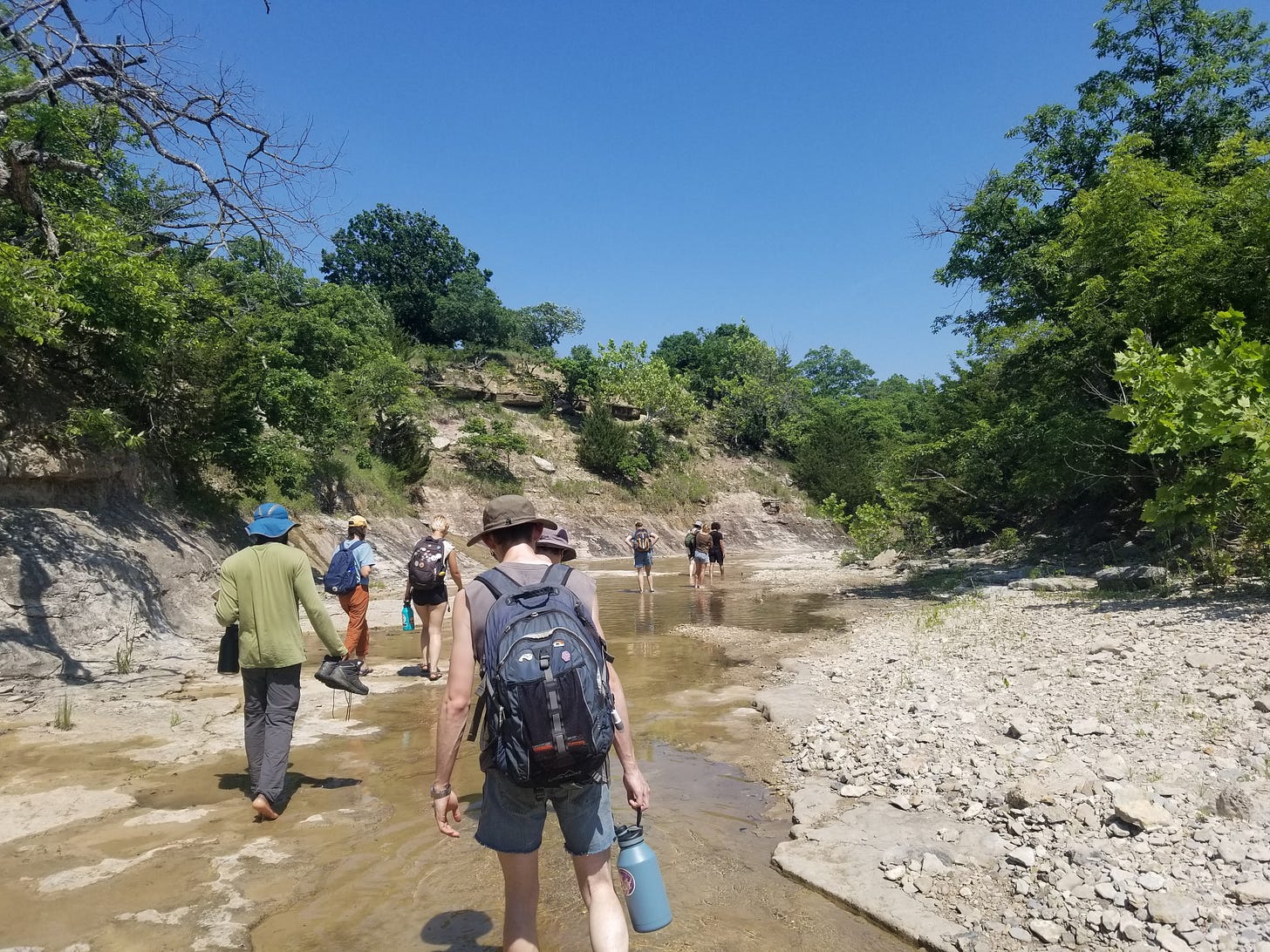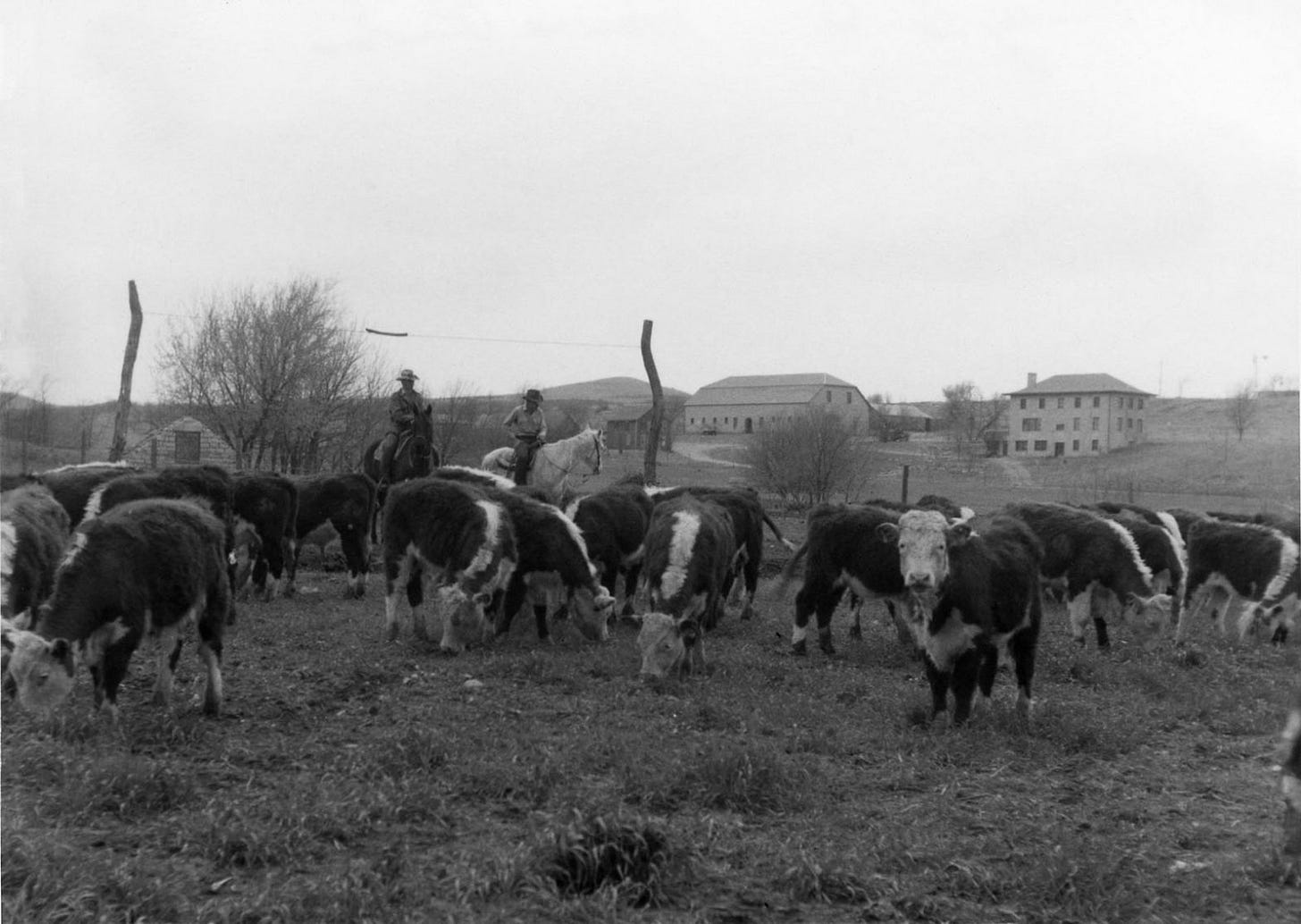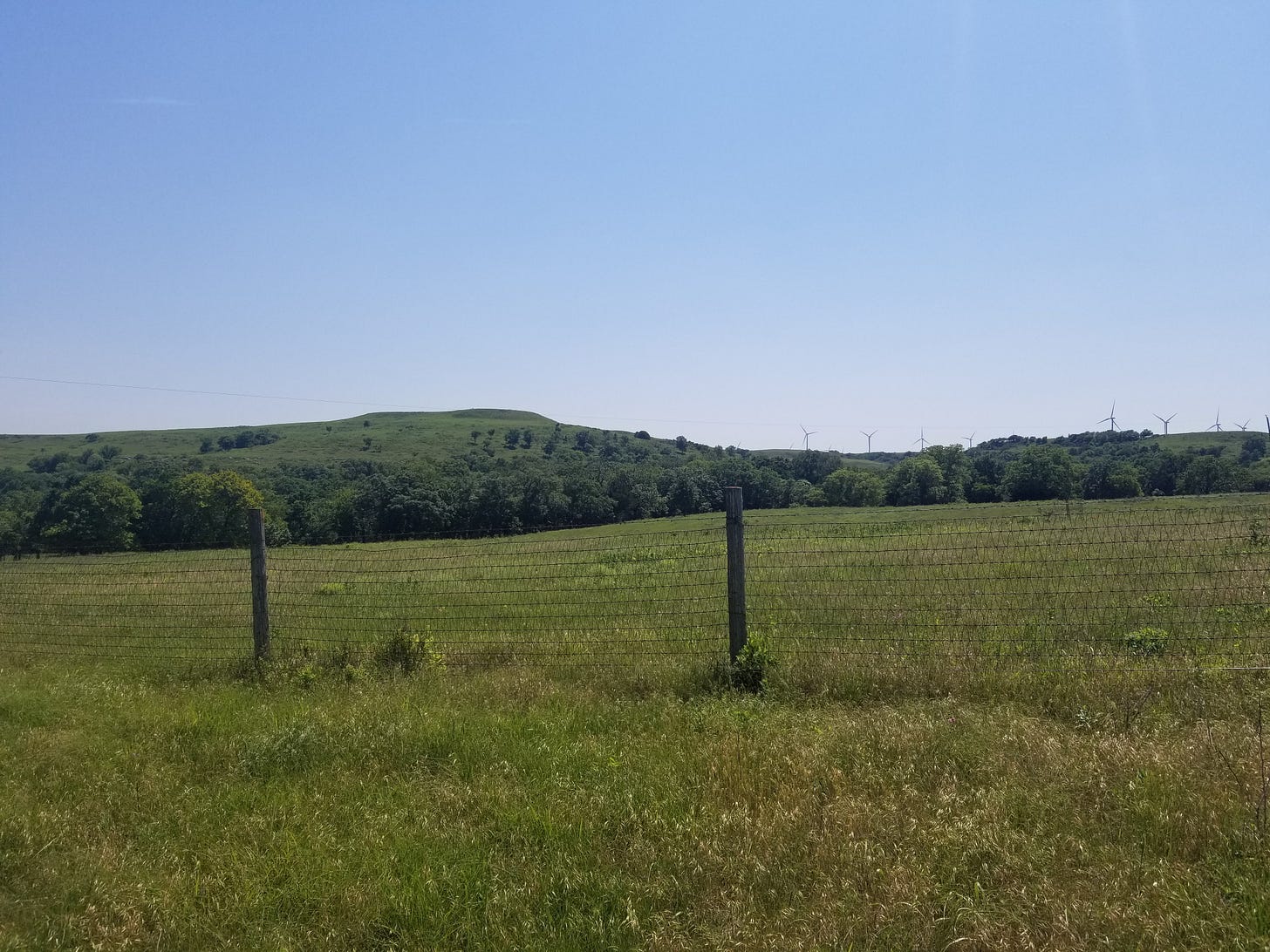The Lost Commons of the Flint Hills
The Flint Hills of Kansas are an expanse of Bluegrass prairie stretching along the eastern third of the state. Due to the large deposits of limestone and shale, the region is difficult to plow, preventing the vast expanses of wheat and sorghum that define the rest of the Kansan landscape from being replicated in the region. With Flint Hills sod left in place, the region has become the largest expanse of prairie remaining in the nation, substituting cattle for the native bison that once roamed the expanse. And, for a time, it was home to one of the few land commons established by Europeans in the United States.
A common is a stretch of land jointly managed by a community, with each member carrying the right to access said parcel for a defined activity. In the Middle Ages, a mosaic of commons dotted the countryside, each associated with different villages and carrying different permissions and responsibilities for residents. Meadows may have been used to graze goats or cattle, or a thicket of woodland exploited for firewood and construction material. These arrangements were central to social and economic life in medieval communities, and participation in governance activities helped build relationships between individuals, communities, and landscapes.
While North America never had as strong a legacy of land commons, several well-developed traditions gained a foothold. In the Spanish territories in what is now Mexico, newly established towns were required to provide communal farming and grazing lands called ejido’s and Dehesa’s (Greer, 2012). In New England, most towns had communal pastures, with some communities having open field systems (Greer, 2012).1 Over time, many of these commons faced privatization as the economic priorities of the day trended toward individual ownership.
The Flint Hills were settled in a time beyond the era of the commons. This was the age of the yeoman farmer; economic development meant the mass transfer of conquered land to individual settlers. Sure, small parcels were sold off to fund universities and schoolhouses, but the dominant economic logic of the day was the private rule of land.
The Flint Hills for a time resisted this logic. The settlement of the region occurred by two parallel processes. The fertile bottomlands along rivers and creeks were settled by crop farmers who tilled the prairie and planted corn and wheat. Meanwhile, the rough uplands, where the plow failed to conquer, were left to prairie for haymaking and grazing (Middendorf et al., 2009). While the bottomlands were divided up between private landowners, the uplands were maintained as an open range, accessible to anyone in the bottomlands to run cattle through. A land advertisement from 1874 encapsulates the framework governing access to this common “For young men with small means and willing hands, Chase County is paradise. Here you can have the great unsettled commons for stock to range upon that costs you nothing except a little looking after” (Middendorf et al., 2008). Farmers bought land with the expectation that they would have the right to access the upland to run cattle for supplemental income. A bundle of communal rights over a parcel of land, acquired through the ownership of another parcel of land.
The anomaly of the Flint Hills commons being able to persevere in Gilded Age America was driven by geography and economics, starting with a lack of resources for fencing. The treeless prairie uplands failed to provision the prodigious volumes of wood necessary to properly enclose the bluegrass. At the time, the fence served as the primary tool in exerting private control over a piece of land, in both a practical and legal sense. Fences enforced boundaries and marked where the rights of the public end and the rights of the individual begin. Such provisions run deep in American Law. The Virginia House of Burgesses, for example, decreed in 1643 that property must be fenced in to exclude wandering livestock (Greer, 2012). If a fence did not exist, an animal’s owner was not liable for the damage their charge wrought on another’s field or garden.
The fact that it was practically impossible to fence in the expansive Flint Hills allowed for an antiquated economic arrangement to be revived. If private ownership could not logistically be imposed, the land fell to communal control. Residents seemed to desire this arrangement. In 1872, one county in Kansas attempted to pass a law that would have required livestock owners to fence in their herds (Hickey & Webb, 1987). The voters rejected the proposal in part to maintain access to the rich grasslands. Communal management wasn’t just an unfortunate inconvenience; it was maintained with popular support.
That is until technology found a solution. Histories of agricultural technology will christen Illinois’ Joseph Glidden as the inventor of barbed wire, however, the author of this piece, an Iowan partisan, will forever maintain that this revolutionary fencing was invented in his home county in Eastern Iowa (Mullenbach, 2017). Regardless, this innovation utilized far less wood than traditional split-rail fences. This, along with the expansion of the railroad which allowed for wire to be shipped in at low cost, allowed for the rapid enclosure of the formerly daunting Flint Hills.
During the period of open range, farmers in the lowlands operated under the assumption that the uplands would be accessible to them in perpetuity. Thus, they did not expend much capital in acquiring formal title to the upland (Middendorf et al., 2009). Grazing, after all, was only a supplement to their income, and they assumed no one would ever fence the rough and rocky plains. During this period, however, large ranching concerns built expansive prairie holdings through the railroads, who owned the land on paper (Specht, 2020). Once barbed wire became commercially viable, these ranches were in a prime position to rapidly remove the land from public use.
This privatization, counterintuitively, may have saved the Flint Hills from wider ecological devastation. Today, the Flint Hills are one of the few remains of the Tallgrass prairie, containing several hundred square miles of mostly intact prairie. While this region is less biologically diverse than before colonization, it is a small miracle that such a strong ecosystem has persisted while the rest of the Tallgrass has been tilled under.
Further west, the open range persisted as an economic arrangement, as even barbed wire failed to contain the vast expanses of Montana and Wyoming. The Open Range invited substantial stocking rates, a level of grass consumption that the variable rainfall failed to underwrite (Reiman, 2013). Many cattle were lost once grass production collapsed, showcasing the shortcomings of unfettered access to public grazing land. The western range, much like the Flint Hills, would eventually enclose, albeit under much more traumatic conditions, and transition into a leasing system (Fletcher, 1929). It's possible that, had the Flint Hills continued to operate under an Open Range, it would have experienced an era of massive overgrazing.2
The open range was a vestigial institution from the era of common land. An arrangement that, due to limitations of technology and geography, was allowed to persist in an era of enclosure. This vestigial status, however, came without the cultural knowledge of how to engage with a common. Those managing the western ranges knew nothing of collective management or consensus decision-making; processes fundamental to governing a common (Ostrom, 1990). The lack of such arrangements in the era of private ownership doomed the open range to grave mismanagement. The proverbial tragedy of the commons, the oft-misunderstood parable of how collective ownership leads to the degradation of resources, stems not from the sharing itself but from eschewing the responsibility for collective action. The open range failed because ranchers went into the region with a private enterprise mindset for managing a public good. The logic of privatization applied to a communal resource.
Perhaps enclosure saved the Flint Hills from this fate. The deep bluestem grasslands are an enduring legacy of the prairie that once spanned much of North America. These grasslands have remained uniquely healthy, an island of perennials amidst a sea of corn and wheat. Had the Flint Hills commons persisted, would the overgrazing that plagued the land further west have compromised the region's ecology? Collective management, without the cultural knowledge to make it function, may have in the end doomed these waves of grass.
What I’m Reading, Watching, and Listening to
How not to build a sustainable community: A retrospective on the authors experience living in a poorly run intentional community.
The Brutal Business of Texas BBQ: I’m very excited to see that craft and tradition are still valued in some corners of the economy, and this video deep dive serves as a valuable case study of that fact.
The Righteous Gemstones: The first show I’ve been able to binge in years.
References
Anderson, K. (1953). Utilization of Grasslands in the Flint Hills of Kansas’. Journal of Range Management, 6(2), 86–93.
Fletcher, R. S. (1929). The End of the Open Range in Eastern Montana. The Mississippi Valley Historical Review, 16(2), 188–211. https://doi.org/10.2307/1902901
Gilles, J. L., & Jamtgaard, K. (1981). Overgrazing in Pastoral Areas the Commons Reconsidered. Sociologia Ruralis, 21(1), 129–141. https://doi.org/10.1111/j.1467-9523.1981.tb00298.x
Greer, A. (2012). Commons and Enclosure in the Colonization of North America. The American Historical Review, 117(2), 365–386. https://doi.org/10.1086/ahr.117.2.365
Hickey, J. V., & Webb, C. E. (1987). The Transition from Farming to Ranching in the Kansas Flint Hills: Two Case Studies. Great Plains Quarterly, 7(4), 244–255.
Middendorf, G., Becerra, T. A., & Cline, D. (2009). Transition and Resilience in the Kansas Flint Hills. Online Journal of Rural Research & Policy, 4(3). https://doi.org/10.4148/ojrrp.v4i3.109
Middendorf, G., Cline, D., & Bloomquist, L. (2008). Agrarian Landscape Transition in the Flint Hills of Kansas. In Agrarian landscapes in transition: Comparisons of long-term ecological and cultural change. Oxford Univ. Press.
Mullenbach, C. (2017, September 23). Iowa’s 1880s Big “Beat ‘Em-all Barbed Wire Company” Patent Controversy. Investigate Midwest. http://investigatemidwest.org/2017/09/23/iowas-1880s-big-beat-em-all-barbed-wire-company-patent-controversy/
Ostrom, E. (1990). Governing the Commons: The Evolution of Institutions for Collective Action. Cambridge University Press.
Reiman, V. (2013). The Rise and Fall of Open-Range Cattle Raising on the Montana Plains. Montana Historical Society.
Specht, J. (2020). Range. In Red Meat Republic: A Hoof-to-Table History of How Beef Changed America. Princeton University Press.
It's also worth noting that, despite our idea of commons as universally good, they played an important role in establishing colonial projects. Commons allowed for the economic use of a landscape where the technological and geographic conditions denied the establishment of individual ownership. Settlers could still engage in the dispossession of indigenous land and utilize it for nation-building purposes even if the preferred model of parcelization was unrealistic. The common, despite its communal nature, could still be a weapon of colonization. The replacement of indigenous communal management with settler communal management.
There are other reasons the Flint Hills persisted, of course. Thanks to its position between larger grazing regions in Texas and the packing houses of the Midwest, the Flint Hills took on a role as finishing ground. Steers would be brought in at the beginning of the season, fattened up on the spring surge in grass production, and shipped off to market by the middle of summer (Anderson, 1953). Normally, such intensive spring grazing would spell disaster, but the ample rest period over late summer and fall allowed the land to heal.





